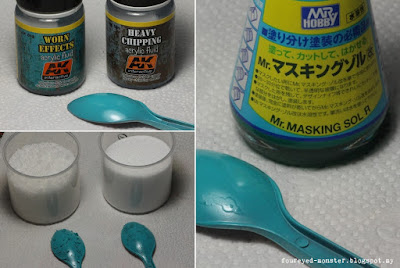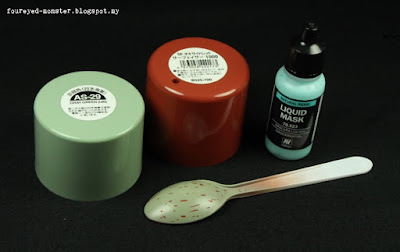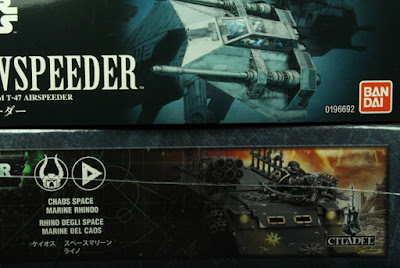 |
| Paint chipping using (from left to right): Mr Masking Sol R, Vallejo Liquid Mask and AK Worn Effects |
 |
| More paint chipping with (left to right): Coarse grain salt, fine grain salt and AK Heavy Chipping |
This test was carried out in the following order:
1) Apply rust coloured primer (Tamiya Fine Surface Primer or Mr Surfacer Red Oxide);
2) Apply chipping material (salt, liquid mask or acrylic chipping fluid);
3) Allow sufficient dry time (overnight for the salt while about 30 minutes for the others);
4) Spray on Tamiya Synthetic Lacquer paint (TS-41 Coral Blue and AS-29 Gray Green IJN);
5) Remove basecoat paint using an old toothbrush, paint brush or toothpick as a form of abrasive.
Additional notes: (a) To enable a thin coat of water to stay long enough on the primed plastic spoons for sprinkled salt to stick to it, I first applied a thin coat of Vallejo Polyurethane Matt Varnish.
(b) The abrasive tool must first be wet with water when using it on AK Interactive chipping fluids.
 |
| Test spoons were sprayed with Tamiya Fine Surface Primer followed by its TS-41 Coral Blue paint |
 |
| How some of the test spoons looked like after spray paint was applied on top of the chipping materials |
In hindsight I should have set up a control to make it a true scientific experiment. That control - a test sans step two - is particularly important to confirm that the chipped paint effect actually arises from the use of AK088 and AK089 and not just through the abrasive effect of a toothbrush/toothpick. As I understand it, both AK products are meant for use with acrylic paints but I've seen some weathering magazines state they could be used with any type of paint. Based on past experience, I find it easier to chip acrylic paint compared to lacquer paint. But at least the paint still (seemingly) chips.
 |
| Results of the paint chipping experiment on Tamiya synthetic lacquer spray paint |
 |
| Closeup of how the various chipping materials affect Tamiya synthetic lacquer spray paint |
Unhappy with the large uncontrolled blobs of peeled paint which resulted from the use of masking fluids, I decided to redo that part of the test using the Vallejo Liquid Mask. To mix things up a bit, I used Mr Hobby's primer together with a new spray paint colour. This time around I applied the mask in a more judicious manner with the mantra less is more. As you can see below, a subtler effect can be achieved using liquid mask. And I'm sure better controlled results will be gained with experience.
 |
| Retested with the Vallejo Liquid Mask to see if more refined results could be obtained |
My weathering journey starts with two sci-fi vehicles i.e. the Bandai Star Wars 1/48 scale Snowspeeder and an old neglected Chaos Rhino Transport. Technically, the latter qualifies as an armoured fighting vehicle (AFV) albeit of the make-believe kind. But more than that, I'm actually contemplating something a tad crazier. It involves working on four weathering projects at the same time, which would mean adding two military AFVs into the mix. Weathering is not limited to just paint chipping of course. Included are rust stains/streaks, dirt, mud and general environmental effects.
 |
| Sneak peek 01: an Incom Corporation T-47 Airspeeder and a Chaos Rhino Transport |
 |
| Sneak peek 02: the Russian Medium Tank T-55A and German Leopard 2 A5 |
Funnily enough I wouldn't be abandoning my miniature figure painting roots as I embark on these sci-fi vehicle and military AFV projects. All model kits shown above have accompanying miniature figurines for scale and I plan to paint the figures for at least three out of the four kits. More on this new journey soon enough. All I have to do now is to figure out how I'm going to cram so much hobby work into so little free time. I wonder if a TARDIS would help. Wouldn't hurt I guess.
 |
| My kingdom for a TARDIS, and I would gladly pay you Tuesday for one today |
With that I leave you with a Doctor Who quote that just about sums up my hobby predicament at this moment in time ... Do what I do. Hold tight and pretend it’s a plan!


Great test! My favorite is the coarse grain salt.
ReplyDeleteI'm looking forward to see you using it on the vehicles.
Greetings
Great one. Thank You for a review :)
ReplyDeleteMy word that is an exhaustive test and beautifully illustrated. I have to say that my favourite result, on the face of things, is the course grain salt. Really looking forward to the Snowspeeder now!
ReplyDeleteYour blog is truly educational. Looking forward to your work on those! :)
ReplyDeleteLove this, very instructive, I've used masking fluid as well bu tI always tend to do too regular shapes which is why I've opted for foam weathering instead, it still is a good tool to have.
ReplyDeleteNice and effective!
ReplyDeleteI've been meaning to get into chipping. Thanks for the tips.
ReplyDeleteInteresting experiment. I've seen people using salt.
ReplyDelete